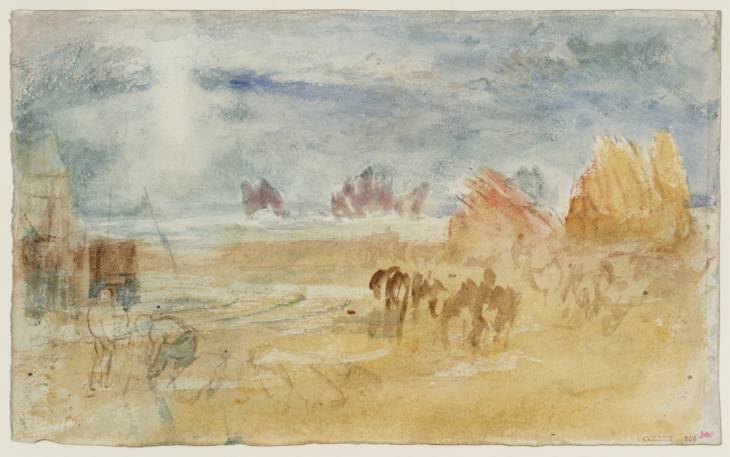Joseph Mallord William Turner Sand-Landing by Moonlight on the North Devon or Cornish Coast c.1823
Joseph Mallord William Turner,
Sand-Landing by Moonlight on the North Devon or Cornish Coast
c.1823
Joseph Mallord William Turner 1775–1851
Sand-Landing by Moonlight on the North Devon or Cornish Coast c.1823
D25423
Turner Bequest CCLXIII 300
Turner Bequest CCLXIII 300
Watercolour on white wove paper, 149 x 242 mm
Blind-stamped with Turner Bequest monogram towards bottom right
Inscribed in red ink ‘300’ bottom right
Stamped in black ‘CCLXIII – 300’ bottom right
Blind-stamped with Turner Bequest monogram towards bottom right
Inscribed in red ink ‘300’ bottom right
Stamped in black ‘CCLXIII – 300’ bottom right
Accepted by the nation as part of the Turner Bequest 1856
Exhibition history
1997
Turner’s Watercolour Explorations 1810–1842, Tate Gallery, London, February–June 1997, Southampton City Art Gallery, June–September (41, as ‘“Sand-Landing” by Moonlight on the North Devon or Cornish Coast’, c.1823, reproduced in colour).
2006
Light into Colour: Turner in the South West, Tate St Ives, January–May 2006, Plymouth City Museum and Art Gallery, May–August (no number, as ‘“Sand Landing” by Moonlight’, c.1823).
References
1820
A.J. Finberg, A Complete Inventory of the Drawings of the Turner Bequest, London 1909, vol.II, p.837, CCLXIII 300, as ‘The Needles (?)’, c.1820–30.
1823
Eric Shanes, Turner’s Watercolour Explorations 1810–1842, exhibition catalogue, Tate Gallery, London 1997, pp.11, 13, 28, 59–60 no.41, as ‘“Sand-Landing” by Moonlight on the North Devon or Cornish Coast’, c.1823, reproduced in colour p.60, pp.94 Appendix I ‘Cornwall’ and ‘Devonshire’, 98 Appendix I ‘Industrial Scenery’, 100 Appendix I ‘Moonlight Depictions’, 102 Appendix I ‘Southern Coast of England series’ and ‘Unfinished Watercolours’.
1823
Sam Smiles, Light into Colour: Turner in the South West, exhibition catalogue, Tate St Ives 2006, reproduced in colour p.44, p.55 no number as ‘“Sand Landing” by Moonlight”’, c.1823.
Partly on account of its style and commensurate size, Eric Shanes has proposed this unfinished watercolour as an abandoned early 1820s subject for the Southern Coast (see the Introduction to this section), based on a small pencil drawing in the 1811 Devonshire Coast, No.1 sketchbook (Tate D08368; Turner Bequest CXXIII 4).1 Because of the particular formation of the rocks and their brown tint, he concludes that they are of sandstone, thus limiting the possibilities to Cornwall and North Devon, probably ‘on the west-facing coasts of the Hartland peninsula, or between Saunton Sands and Morte Point, Devon’;2 for other Bristol Channel sketches with similar rocks, see under D08368.
The beaches along that stretch are full of lime-rich sea shells, and Turner seems to be recording ‘sand-landing’ – the removal of sand to be used on local agricultural land to neutralise the soil. In the drawing there seem to be carts in the distance approaching a vessel; in the equivalent position here is a ship which Shanes in his detailed discussion suggests may be bringing lime from South Wales, as well as figures loading a donkey at the centre, indicated in loose brown strokes.3 The watercolour Clovelly Bay, North Devon (National Gallery of Ireland, Dublin),4 engraved for the Southern Coast in 1824 (Tate impressions: T05446, T05990), shows men and donkeys in relation to lime kilns, and Turner perhaps felt the present subject too similar in its industrial focus, not redeemed in this case by a picturesque setting;5 nevertheless he went to the trouble of introducing quite carefully delineated figures, ‘having moved beyond the sketch or study stage ... for Turner usually only elaborated his staffage when he intended to take a work to completion’.6
A watercolour described as a ‘Colour beginning: A coastal landscape with a figure in the foreground’ dated to about 1822–4 (private collection)7 is on the same scale and employs a similar range of blues and browns, albeit for a daylight scene. It too has been linked to the Southern Coast and compared with Clovelly Bay, as well as Combe Martin, Devonshire (Ashmolean Museum Oxford),8 engraved in 1825 (Tate impressions: T04416–T04418, T05449) and Boscastle, Cornwall (also Ashmolean),9 engraved in 1825 (Tate impressions: T05444–T05445). Pencil drawings tentatively linked to it are 1811 views of Bude (Cornwall) in the Devon and Cornwall sketchbook (Tate D41318; Turner Bequest CXXV a 40) and of Lynton and Lynmouth (Devon) in the Somerset and North Devon sketchbook (Tate D08962; Turner Bequest CXXVI 16).10 The distinctive profiles of the cliffs in each case are not close to the watercolour’s; another possibility is Tate D08465 (Turner Bequest CXXIII 53) in the 1811 Devonshire Coast, No.1 sketchbook, a pencil drawing of a cove or bay, perhaps in South Devon, which includes figures and indistinct foreground elements in corresponding positions. As noted above, the present study was based on another page in the same book.
Not in Wilton 1979; withdrawn from auction at Christie’s, London, 5 July 2016 (101); see the entry for the work at Christie’s, accessed 25 July 2016, http://www.christies.com//lotfinder/drawings-watercolors/joseph-mallord-william-turner-ra-colour-beginning-6009996-details.aspx .
See entry at Christie’s, accessed 25 July 2016, http://www.christies.com//lotfinder/drawings-watercolors/joseph-mallord-william-turner-ra-colour-beginning-6009996-details.aspx .
Technical notes:
Some details are drawn with the point of a fine brush. The dark blue around the standing figure’s head has been lifted out with a fingertip; as Eric Shanes has noted, there are similar marks among the rocks on the right.1 The effect of a misty halo of pale moonlight has been achieved by washing out the colour in that part of the sky.
Verso:
Blank; inscribed by ?John Ruskin in red ink ‘[?1259]’ bottom left; inscribed in pencil ‘CCLXIII 300’ bottom right.
Matthew Imms
July 2016
How to cite
Matthew Imms, ‘Sand-Landing by Moonlight on the North Devon or Cornish Coast c.1823 by Joseph Mallord William Turner’, catalogue entry, July 2016, in David Blayney Brown (ed.), J.M.W. Turner: Sketchbooks, Drawings and Watercolours, Tate Research Publication, February 2017, https://www

